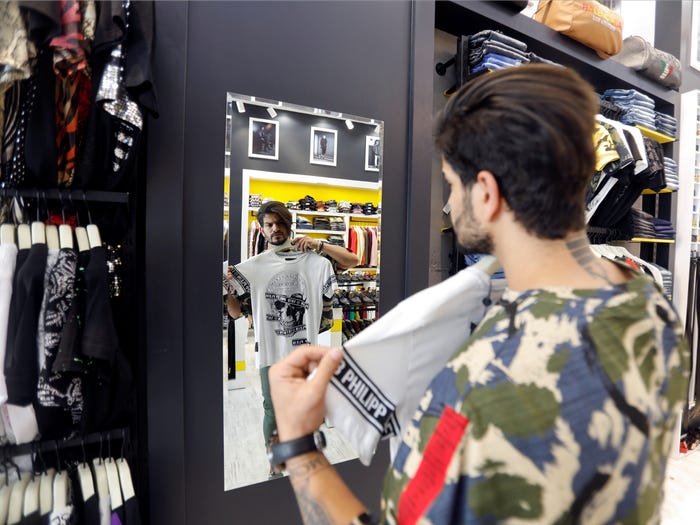Sustainable fashion is in, so try these tips for keeping your closet eco-friendly

A few minutes every morning is all you need.
Stay up to date on the world's Headlines and Human Stories. It's fun, it's factual, it's fluff-free.
It’s 2021, and if you’re not trying to green-ify your life, it’s time – and sustainable fashion is a good starting point. While it’s true that the majority of carbon emissions cannot necessarily be attributed to the practices of individual consumers, we can all influence change in the industries and companies with the most harmful environmental practices based on our purchasing habits. As the saying goes, you can “vote with your wallet.” If there’s anything you can do to help the environment, just look at your power as a consumer in the global economy.
In 2017, CDP reported in their “Carbon Majors” research that 71% of the world’s greenhouse gas emissions over the previous two decades could be attributed to just 100 fossil fuel producers. And in 2019, “The Guardian” revealed that just 20 fossil fuel companies contribute to an entire third of global carbon emissions. This information comes from reports completed by the Climate Accountability Institute, a major source on climate change research.
One significant area of your life that may not be as obviously in need of change is your closet. However, the fashion industry is notorious for its counter-environmental operations, especially when it comes to fast fashion. In short, “fashion production makes up 10% of humanity’s carbon emissions, dries up water sources and pollutes rivers and streams.”
In conversation with Katy Poyner, founder of fashion retailer Anaphe Online, she attributes much of the industry’s environmental impact to overproduction. Poyner explains, “the waste exceeds 92 million tons per year.” Slow fashion brands, like Anaphe, “only produce small quantities of limited styles,” to reduce this issue. Anaphe’s packaging is also biodegradable. Details like these can make a big difference in choosing brands that align with your values.
In an exclusive with TMS, Poyner shared a major tip for being fashionable while prioritizing environmental concerns. “We suggest being conscious about your choice of material and style when purchasing,” she says. “Look for items that are quality and timeless – something you can wear all seasons and style [in] many ways. This is the basic concept of Anaphe; a timeless capsule wardrobe that can be worn from waking up to coffee dates, office meetings and styled up for an evening out. We want our customers to style each piece many ways and reduce the fast fashion purchases in favor of quality, timeless pieces.”
Let’s take a look at how you can transform your wardrobe to maximize sustainability (while remaining chic and self-expressive, of course).
The biggest question in sustainable fashion: to shop or not to shop?
The easiest way to change your purchasing habits to reduce fashion waste is not to purchase anything at all. Be a mindful shopper. Consider what you already have, and ask yourself if you really need more. Overconsumption is a significant driver of fast fashion.
Yes, H&M has awesome prices, so it’s tempting to spend a little cash on something cute that you may not need. However, resisting that urge can be a significant cost-effective way to stay environmentally conscious.
If you do need to shop for new clothes, though, don’t beat yourself up about it! We all need to replace clothing from time to time that no longer fits our bodies or personalities. You deserve to wear clothes that you feel good in. However, to be a mindful shopper, you should try making a list of exactly what you need and try not to overbuy outside of that list. Also, buying key pieces that can be styled in many ways is not just a great sustainable fashion tip, but a good style tip in general. Trends come and go, but some pieces are timeless, like that LBD you can dress up or down or a solid pair of well-tailored jeans.
You can also shop secondhand at a consignment shop, thrift store or charity shop in your area. You’d be surprised how many inexpensive treasures you can find at these shops. Lastly, consider checking out sustainable fashion brands to find new clothes from a company actively working against fashion and textile waste.
Restoring old clothes
Sometimes, we may not need or want new clothes, but the pieces in our closets need a little TLC. So, rather than buying new clothing, why not repair and restore some of your favorite garments to get a bit more life out of them?
While we may not all be seamstresses, chances are you’ve got one in your area. Take in too-big or let out too-small clothing by heading over to your local dry cleaner to see if they have mending services. Tailors and sewists can also help you repair clothes with rips or other structural issues. Not to mention, tailored clothing often fits better (and therefore looks better) on your body.
And, hey, maybe it’s time you learned how to use a needle and thread yourself. There are YouTube tutorials for everything. Now that grunge is back in, you can also call the whole thing in and embrace the lo-fi look. Use visible safety pins and bleach-dye that faded black T-shirt that you love. Make more holes in that sweater if you don’t feel like fixing the hole that’s already there. Rules don’t exist in fashion.
Plus, you can really let your creative side show with clothes that no longer excite you. Consider getting yourself an embroidery kit and reanimate your wardrobe by putting your own spin on what you already have. Or a tie-dye kit. Set your inner artist free.
When in doubt, trade and rent
Hey, whoever said the clothes you wear have to be your own? If you need a specific piece that you don’t already have for an event or activity, you don’t have to buy it.
Instead, consider asking to borrow something from a friend. Or, if you and a few friends wear similar styles in similar sizes, you can always do a big clothing swap. Get together with the clothes each of you no longer wears and go through the pieces, trading them with each other. Hand-me-downs have never looked so cool.
There are also some startups that allow you to rent the clothes you need, especially for formal occasions. After all, do you really attend enough black-tie events to warrant that many outfits? Plus, embracing sustainable fashion doesn’t mean you need to wear the same thing constantly. If you’re getting photographed a lot, you also may want to wear something different for every event. And afterward, these dresses and jumpsuits just sit in your closet, rarely worn again. Kind of wasteful, no? Be kind to the earth (and your wallet) by renting clothes through services like Rent the Runway and Style Lend.
What to do with your old clothes
While you can trade older clothes with a friend, or give them to a younger cousin, sometimes no one wants them. And there are some things in your dresser that just aren’t salvageable enough to donate, either. It’s important not to just throw these in with your regular trash. As clothing decomposes in landfills, it exposes toxic gases that are terrible for the environment.
Instead, find a local textile recycling center. It’s not surprising if you haven’t heard of textile recycling before because it’s unfortunately not as popular as glass, metal and plastic recycling. However, it’s just as necessary. Because there may not be a textile recycling area close to where you live, it should also be noted that Goodwill does recycle all unsellable donations. Please do not donate clothes that really should be recycled, though. Thrift stores such as these depend on donations of wearable, sellable clothing.
Have a tip or story? Get in touch with our reporters at tips@themilsource.com




Comments ()